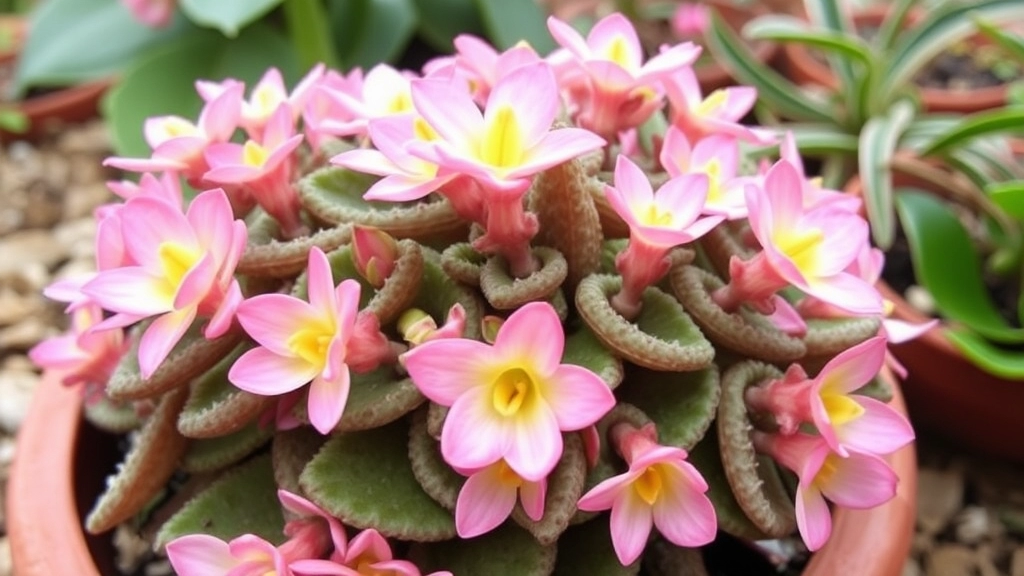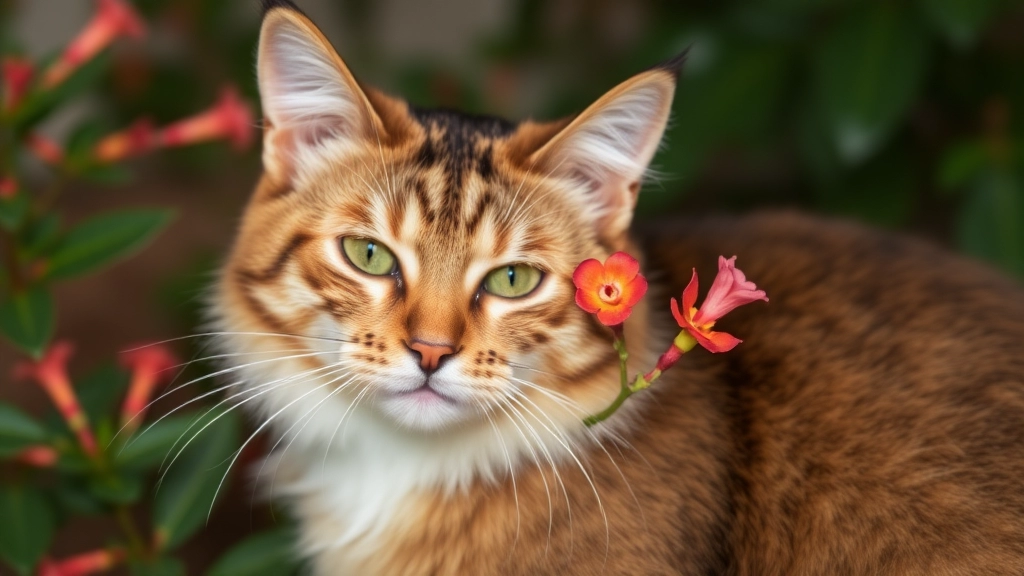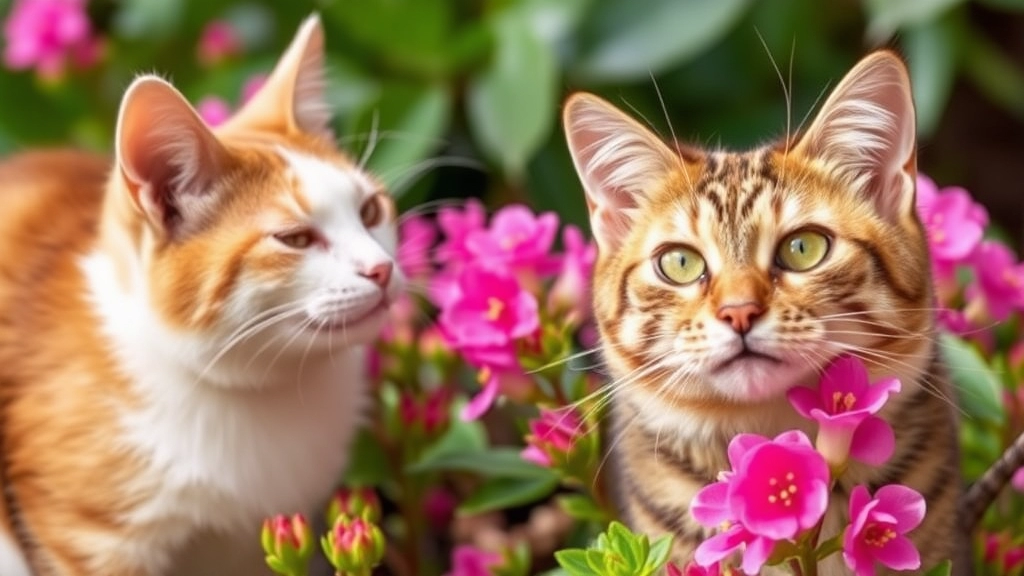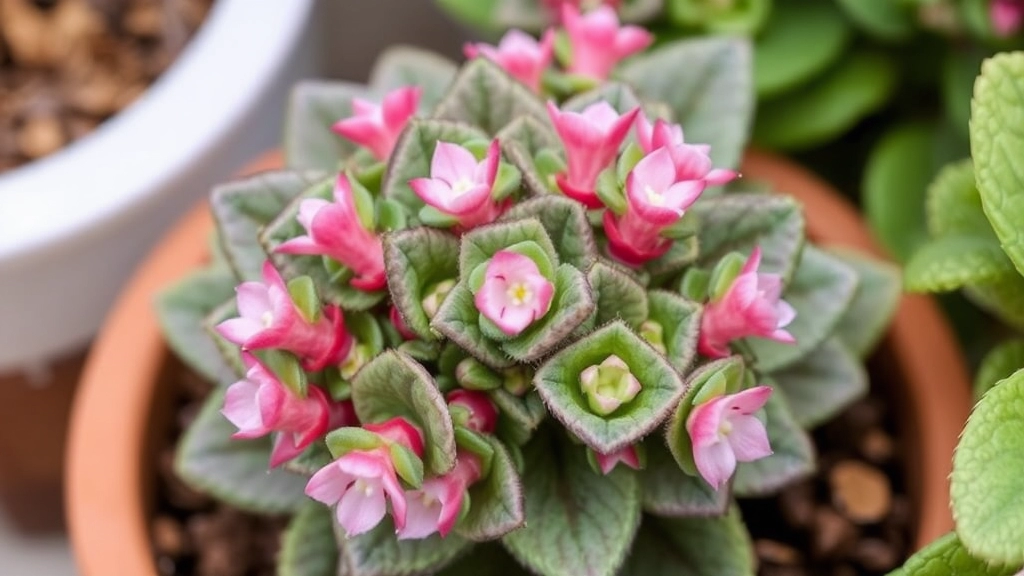Is Calandiva Kalanchoe Safe for Cats?
As a cat owner and plant lover, I often find myself wondering if my favourite houseplants are safe for my furry friends. One popular plant that caught my eye is the Calandiva Kalanchoe. But is Calandiva Kalanchoe safe for cats? Let’s dig into it and find out.
Importance of Pet-Friendly Plants
When it comes to keeping our homes both green and pet-friendly, it’s crucial to know which plants can coexist with our cats. Calandiva Kalanchoe, with its vibrant blooms, is a stunning addition to any home decor. However, ensuring that our cats are not at risk is always a top priority. So, let’s explore the safety of Calandiva Kalanchoe for our feline companions.
Are you a cat owner who loves to decorate your home with beautiful plants? If so, you may have come across the Calandiva Kalanchoe, a popular choice among indoor gardeners.
The Calandiva Kalanchoe is a stunning succulent known for its vibrant, multi-petaled flowers.
### Key Features of Calandiva Kalanchoe:
– **Appearance**: This plant boasts thick, fleshy leaves and clusters of bright blooms, typically in shades of pink, red, or white.
– **Care**: It thrives in bright, indirect sunlight and requires minimal watering, making it an ideal choice for busy individuals.
– **Growth**: Generally, it reaches a height of about 30 cm (12 inches) and can bloom multiple times a year under the right conditions.
While its beauty is undeniable, it’s crucial for cat owners to be aware of its potential risks. The Calandiva Kalanchoe is classified as [toxic to cats](https://planthq.org/are-kalanchoe-plants-poisonous-to-pets-and-humans/), which raises concerns for those who wish to keep both their pets and plants safe.
For those interested in more detailed care instructions, check out this [complete care guide for Kalanchoe plants](https://planthq.org/kalanchoe-flapjack-care-ultimate-guide-for-healthy-growth/).
Common Characteristics of Calandiva Kalanchoe

So, you’re curious about Calandiva Kalanchoe? You’re not alone! Many plant lovers are drawn to this vibrant beauty, but what makes it so special?
Appearance
- Flowers: Calandiva Kalanchoe is famous for its stunning, double-petal flowers that bloom in a variety of colours, including pink, red, and yellow. They’re like little bursts of joy!
- Leaves: The leaves are thick and fleshy, almost succulent-like, with a glossy green finish. They store water, making this plant quite hardy.
Growth Habit
- Size: Typically, it grows to about 30-45 cm tall, making it perfect for tabletops or windowsills.
- Habit: It has a bushy growth habit, which means it fills out nicely and can be quite eye-catching in any room.
Care Requirements
- Light: Calandiva loves bright, indirect sunlight. A little bit of direct sun won’t hurt, but too much can scorch those lovely leaves.
- Water: Being a succulent, it prefers to dry out between waterings. Overwatering can lead to root rot, so it’s best to err on the side of caution.
Lifespan
- Longevity: With proper care, Calandiva can live for several years, bringing joy with its vibrant blooms season after season.
Toxicity of Calandiva Kalanchoe to Cats
As a cat owner, you may be concerned about the safety of your indoor plants, especially when it comes to the Calandiva Kalanchoe.
Understanding Toxicity Levels
Calandiva Kalanchoe, while a beautiful addition to your home, is classified as toxic to cats. This plant contains compounds called bufadienolides, which can be harmful if ingested. Here’s what you need to know:
- Toxicity Classification: The ASPCA lists Calandiva Kalanchoe as toxic to cats.
- Risk Factors: Cats that are curious and prone to nibbling on plants are at higher risk.
What Makes It Toxic?
The toxicity of Calandiva Kalanchoe can lead to various health issues in cats. Key points to consider include:
- Chemical Composition: Contains bufadienolides that can disrupt normal heart function.
- Potential Risks: Even small amounts can lead to adverse reactions.
Understanding these factors is crucial for ensuring your feline friend remains safe in a plant-filled environment. For more detailed information, you can refer to our article on Kalanchoe toxicity to cats and learn about essential safety information to protect your pets.
Symptoms of Calandiva Kalanchoe Poisoning in Cats

When it comes to our feline friends, the last thing we want is for them to suffer from poisoning due to plants like Calandiva Kalanchoe. If you suspect your cat has ingested this plant, it’s crucial to be aware of the symptoms that may arise.
Common Symptoms of Calandiva Kalanchoe Poisoning:
- Vomiting: This is often one of the first signs. If your cat starts to vomit after being around the plant, take note.
- Diarrhoea: Loose stools can indicate gastrointestinal distress, which can be linked to ingestion.
- Lethargy: A sudden drop in energy levels or enthusiasm for play can be concerning.
- Loss of Appetite: If your cat shows disinterest in food, it may be a sign of discomfort.
- Abdominal Pain: Watch for signs like hiding, reluctance to be touched, or unusual postures.
- Drooling: Excessive salivation can occur as a response to nausea.
Each of these symptoms can vary in severity, and not every cat will exhibit all of them.
If you notice any of these signs, it’s essential to act swiftly.
Immediate Actions if Your Cat Ingests Calandiva Kalanchoe
If you suspect that your cat has ingested Calandiva Kalanchoe, it’s crucial to act swiftly. The potential toxicity of this plant can lead to serious health issues for your feline friend.
Here’s what you should do right away:
- Stay Calm: Your reaction matters. Remaining composed will help you think clearly.
- Assess the Situation: Determine how much of the plant your cat has consumed. If you can, take a photo of the plant and note the quantity ingested.
- Check for Symptoms: Look for any immediate signs of distress in your cat, such as:
- Vomiting
- Diarrhoea
- Lethargy
- Loss of appetite
- Do Not Induce Vomiting: Unless directed by a veterinarian, do not attempt to make your cat vomit. This could cause further harm.
- Contact Your Veterinarian: Call your vet or an emergency animal clinic immediately. Provide them with details about the ingestion and any symptoms you’ve noticed.
- Follow Veterinary Instructions: Your vet may advise you to bring your cat in for an examination, or they might provide guidance over the phone.
- Keep the Plant: If possible, take a sample of the plant with you to the vet. This can help them in diagnosing and treating your cat.
Taking these actions promptly can make a significant difference in your cat’s recovery. Additionally, familiarize yourself with the toxicity of Kalanchoe Tomentosa to better protect your pets. For a broader understanding, you might also want to explore the medicinal uses and benefits of Kalanchoe.
Safe Alternatives to Calandiva Kalanchoe for Cat Owners

If you’re worried about having Calandiva Kalanchoe in your home due to its toxicity to cats, you’re not alone. Many cat owners want to create a vibrant indoor garden without risking their furry friends’ health.
Here Are Some Safe Alternatives:
- Spider Plant: These are super easy to care for and safe for cats. Plus, they look great hanging or on a shelf!
- Boston Fern: Not only does it add a lush feel to your space, but it’s also non-toxic. Just keep it a bit moist, and it’ll thrive.
- Areca Palm: This palm is pet-friendly and can grow quite tall, making it a stunning addition to your living room.
- Bamboo Palm: Another palm option that’s safe for cats. It’s also known for improving indoor air quality.
- Calathea: With its striking leaves, this plant is both beautiful and non-toxic to your feline friends.
- Parlor Palm: A classic choice that’s safe for pets and adds a touch of elegance to any room.
These plants not only keep your cat safe but also bring life and colour to your home.
Tips for Choosing Cat-Friendly Plants:
- Research: Always double-check if a plant is safe before bringing it home.
- Check Labels: When buying from a store, look for labels that indicate pet safety.
- Ask Experts: Don’t hesitate to ask staff at garden centres about cat-friendly options.
Preventing Plant Poisoning in Cats
As we delve deeper into keeping our feline friends safe, it’s crucial to consider how to prevent plant poisoning, especially with toxic plants like Calandiva Kalanchoe lurking around.
Why Should You Worry?
Many cat owners often overlook the potential dangers that houseplants can pose. It’s essential to be proactive in safeguarding your pets. Here are some practical steps to help you maintain a cat-friendly environment:
- Research Before You Buy: Always check if a plant is safe for cats before bringing it home. Resources like the ASPCA’s Toxic and Non-Toxic Plants list can be invaluable.
- Choose Cat-Safe Plants: Opt for plants that are known to be non-toxic to cats. Examples include spider plants, cat grass, and Boston ferns.
- Placement Matters: Keep potentially harmful plants out of reach. Hanging planters or high shelves can be effective solutions.
- Create a Barrier: If you have plants that are toxic, consider using physical barriers like decorative screens or plant cages to deter your cat from getting too close.
- Educate Yourself and Others: Share knowledge about toxic plants with family and friends who visit your home. This awareness can prevent accidental ingestion.
- Regularly Inspect Your Plants: Check for any fallen leaves or debris that your cat might find tempting. Remove any hazardous materials promptly.
By taking these steps, you can significantly reduce the risk of plant poisoning in your home. For more information on which plants to avoid, you can read about Kalanchoe plants’ toxicity to pets and humans. Additionally, if you notice any unusual symptoms in your plants, such as leaf discoloration, it might be helpful to check out the causes and fixes for soft Kalanchoe leaves.
Consulting a Veterinarian

So, you’ve just discovered that your curious cat has nibbled on your Calandiva Kalanchoe. You’re probably feeling a mix of panic and confusion. What should you do next?
First off, let’s be real—when it comes to your furry friend’s health, it’s always better to be safe than sorry. Consulting a veterinarian is crucial if you suspect your cat has ingested any part of this plant.
Why You Should Consult a Vet:
- Expertise: Vets know the ins and outs of pet health, including plant toxicity.
- Quick Diagnosis: They can quickly assess your cat’s condition and determine if treatment is needed.
- Tailored Advice: Every cat is different, and a vet can provide specific guidance based on your cat’s size, age, and health history.
What to Prepare for Your Vet Visit:
- Details of Ingestion: How much of the plant your cat ate and when.
- Symptoms: Any signs you’ve noticed, like vomiting or lethargy.
- Your Cat’s Health History: Any pre-existing conditions or medications your cat is on.
Don’t hesitate to call your vet, even if it’s after hours. Many clinics have emergency services or can direct you to one.
Creating a Cat-Friendly Indoor Garden
As we explore the importance of keeping our feline friends safe, it’s essential to consider how to create a harmonious indoor environment. A cat-friendly indoor garden can be a delightful addition to your home, offering both aesthetic appeal and a safe space for your cat to explore.
Key Considerations for a Cat-Friendly Indoor Garden
When planning your indoor garden, keep these factors in mind:
- Non-Toxic Plants: Choose plants that are safe for cats. Some excellent options include spider plants, cat grass, and Boston ferns. Avoid toxic varieties like Calandiva Kalanchoe.
- Accessibility: Ensure that your plants are placed where your cat can easily access them. Cats love to explore, and providing them with safe plants can satisfy their curiosity.
- Stability: Use sturdy pots that won’t tip over easily. Cats may knock over lightweight pots while playing or exploring.
- Height Variation: Incorporate shelves or stands to create vertical space. Cats enjoy climbing, and this can add an interesting dynamic to your garden.
- Interactive Elements: Consider adding cat-safe herbs like catnip or valerian. These can stimulate your cat’s senses and provide entertainment.
Tips for Maintenance
Maintaining a cat-friendly indoor garden doesn’t have to be a chore. Here are some simple tips:
- Regular Watering: Keep an eye on your plants and water them as needed. A dry plant can be unappealing to both you and your cat.
- Pruning: Regularly prune your plants to prevent overgrowth and to ensure they remain safe for your cat. Learn more about pruning techniques to keep your garden in top shape.
- Cleaning: Dust leaves periodically to keep the plants healthy and vibrant.
Creating a Safe Haven
A cat-friendly indoor garden not only enhances your living space but also provides a safe haven for your cat. By carefully selecting plants and considering your cat’s behaviour, you can create an enriching environment that is both beautiful and safe. For more tips on maintaining a healthy garden, check out our winter care tips for plants.
Frequently Asked Questions About Calandiva Kalanchoe and Cats
So, you’re curious about Calandiva Kalanchoe and its effects on our feline friends? You’re not alone! Many cat owners have questions, and I’m here to help clear things up.
Is Calandiva Kalanchoe safe for cats?
The short answer? No. Calandiva Kalanchoe is toxic to cats. If you’re a cat owner, it’s best to keep this plant out of your home.
What symptoms should I look for if my cat eats Calandiva Kalanchoe?
If your cat nibbles on this plant, keep an eye out for symptoms like:
- Vomiting
- Diarrhoea
- Lethargy
- Loss of appetite
These signs can vary, so it’s crucial to act quickly if you notice anything unusual.
Can I keep Calandiva Kalanchoe if I have a cat?
Honestly, it’s not worth the risk. There are plenty of safe alternatives you can enjoy without putting your kitty in danger.
What should I do if my cat ingests Calandiva Kalanchoe?
If you suspect your cat has eaten any part of the plant, don’t panic. Here’s what you can do:
- Remove any remaining plant material.
- Monitor your cat for symptoms.
- Contact your vet for advice.
Are there safe plants I can keep around my cat?
Absolutely! Here are some cat-friendly plants to consider:
- Spider Plant
- Cat Grass
- Bamboo Palm
These options will brighten up your home while keeping your furry friend safe.
How can I prevent my cat from getting into my plants?
Keeping your plants safe from curious paws can be tricky. Here are a few tips:
- Place plants on high shelves.
- Use deterrent sprays.
- Create a designated cat area with safe toys and plants.
Should I consult a vet if I’m unsure about a plant’s safety?
Definitely! It’s always a good idea to check with your vet if you’re uncertain about any plant. They can provide tailored advice for your situation.
What’s the best way to create a cat-friendly indoor garden?
Creating a cat-friendly indoor garden is easier than you think! Here’s a quick guide:
- Choose non-toxic plants.
- Use sturdy pots that won’t tip over.
- Create separate areas for your plants and your cat’s play zone.
FAQs on Calandiva Kalanchoe and Cat Safety
What is Calandiva Kalanchoe?
Calandiva Kalanchoe is a popular houseplant known for its stunning, double-petal flowers that come in various colours such as pink, red, and yellow. It also features thick, fleshy leaves that store water, making it a hardy plant.
Is Calandiva Kalanchoe safe for cats?
No, Calandiva Kalanchoe is not safe for cats. It is toxic to them and can cause several symptoms if ingested.
What are the symptoms of Calandiva Kalanchoe poisoning in cats?
Common symptoms include vomiting, diarrhoea, lethargy, loss of appetite, abdominal pain, and drooling. The severity of these symptoms can vary, and not all cats will exhibit all of them.
What should I do if my cat has ingested Calandiva Kalanchoe?
If you suspect your cat has ingested any part of the Calandiva Kalanchoe, consult a veterinarian immediately. Quick action can help mitigate severe health risks.
Are there any safe alternatives to Calandiva Kalanchoe for cat owners?
Yes, several cat-friendly plants can be used as alternatives, including Spider Plant, Boston Fern, Areca Palm, Bamboo Palm, Calathea, and Parlor Palm. These plants are non-toxic to cats and can add beauty to your home.
How can I ensure a plant is safe for my cat before bringing it home?
Always research the plant beforehand, check labels at the store for pet safety information, and ask experts at garden centres for advice on cat-friendly options.
Why is it important to consult a veterinarian if my cat ingests Calandiva Kalanchoe?
Consulting a veterinarian is crucial because they have the expertise to quickly diagnose and treat your cat. They can provide tailored advice based on your cat’s size, age, and health history.
What information should I provide to the vet if my cat has ingested Calandiva Kalanchoe?
Be prepared to provide details of the ingestion, such as how much of the plant was eaten and when, any symptoms you have noticed, and your cat’s health history, including any pre-existing conditions or medications.
References
-
ASPCA – Toxic and Non-Toxic Plants: Kalanchoe
-
Pet Poison Helpline – Kalanchoe
-
Gardener’s Supply Company – Growing Kalanchoe
